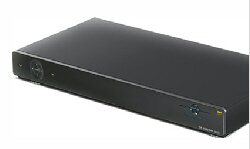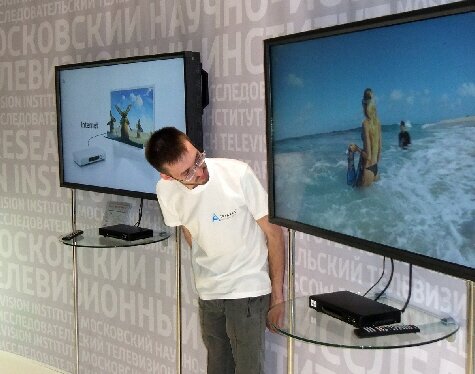Triaxes Develop Realtime MultiView Autostereo 3D Conversion
 Russian company Triaxes Vision have been promoting a solution that extracts autostereo 3D content from a regular two viewpoint stereoscopic feed, in real time, and deliverable over a broadcast network via a IP or HD DVB-T signal.
Russian company Triaxes Vision have been promoting a solution that extracts autostereo 3D content from a regular two viewpoint stereoscopic feed, in real time, and deliverable over a broadcast network via a IP or HD DVB-T signal.

The Glasses Free 3D Challenge
The inherent problem with existing glasses free 3D display technology (parallax and lenticular) is that the video needs to be filmed in a certain way. Glasses free 3D requires at least 5 cameras capturing the action during production or the additional viewpoints can be recreated digitally as a post production process. Small glasses free 3D devices like the LG Optimus 3D smart phone and do not require the extra viewpoints because they are designed for single person viewing, hence the very restrictive viewing zones with such devices. This restriction would not be workable on larger displays but Triaxes solutions are able to recreate the additional viewpoints digitally both in real time and as a post preparation process.
2D + Depth (Twice)
It became possible due to the special auto-stereoscopic format: 2D+Depth. 2D+Depth is a format designed for autostereoscopic displays. In addition to the 2D image, a ‘depth map’ is delivered with the same image. A depth map is a greyscale image. Black elements represent full positive parallax and white elements represent full negative parallax. The 256 greyscales (8-bit) in-between are used by the display to determine the convergence of the multiple views and render smooth depth. You can see an example of how a greyscale bitmap looks in the video below.
Autostereo conversion is not new but the Triaxes system decodes the twin stereo pictures it receives into stereo pictures plus two depth (Z information) maps rather than one depth map. According to Triaxes, using two depth map could improve the quality of autostereoscopic 3D content significantly
Alexey Polyakov, Triaxes Vision CEO told 3D Focus "Generally the 2D + Depth format is very convenient as it’s easy to create 3D content using it. Even when you have only one channel + one grayscale image (depth map) it’s possible to build up a stunning 3D effect. But there also some cons: an issue with transparency and overlapping of background objects. A left and right signal plus two depth maps can solve this AS3D issue because it creates a more realistic 3D effect using the information from left and right channels together with appropriate depth maps. Smooth transition between the simulated frames solves the transparency issue. Moreover , it helps to render the extra views that are not between L&R, but extrapolate original stereo and make the 3D effect stronger that is important for glasses free 3D displays."
 Triaxes also offer software for a autostereo post conversion process called DepthGate. Triaxes DepthGate uses two depth map technology for studio post production. This part automatic / part manual service takes regular 3D content (such as an advert or promo) and adds viewpoints to the existing two so it can be shown on glasses free 3D displays. The number of extra viewpoints required depends on the display manufacturer. DepthGate is compatible with Dimenco and other glasses free 3D display formats such as 5-tile video for Tridelity ASDs, 8 view for Alioscopy, 9 view for Magnetic3D and Exceptional3D (under testing).
Triaxes also offer software for a autostereo post conversion process called DepthGate. Triaxes DepthGate uses two depth map technology for studio post production. This part automatic / part manual service takes regular 3D content (such as an advert or promo) and adds viewpoints to the existing two so it can be shown on glasses free 3D displays. The number of extra viewpoints required depends on the display manufacturer. DepthGate is compatible with Dimenco and other glasses free 3D display formats such as 5-tile video for Tridelity ASDs, 8 view for Alioscopy, 9 view for Magnetic3D and Exceptional3D (under testing).
Triaxes NetJet
Regular stereoscopic content (the type broadcast on the Sky 3D channel) is captured with two cameras – a left and a right frame,but Triaxes Vision have developed a solution which can convert two viewpoint stereoscopic content into autostereoscopic content in real time. The solution, Triaxes NetJet, is compatible with Dimenco ASDs (Dimenco is a spin off from Philips after the Dutch AV company closed its Philips WOWvx autostereo division), the largest of which is 52” and boasts 28 different viewing angles. NetJet could capture and auto adjust video for any type of S3D display as well.
The Triaxes real time system consists of a powerful PC with the NetJet application, Triaxes Media Player and 3D display. Triaxes Media Player plays back 3D video received over IP or DVB-T as well as video stored on flash drive via USB port. The STB supports 2D + Depth and Declipse formats for Philips/Dimenco glasses free 3D displays and other glasses free 3D display manufacturers.
Application of this feature might be real-time conversion of any sport event from S3D with NetJet server and transmission over IP to a numerous low cost [Triaxes Media Players] that are compatible with ASDs.
Triaxes are positioning their solution as a way to efficiently deliver glasses free 3D content over the existing digital (DVB) infrastructure. Broadcasters would not need to use special equipment during the filming process (or post production conversion techniques if everyone had Dimenco displays!). They would be able to transmit their stereoscopic content after being processed by the Triaxes NetJet conversion server on the broadcaster’s side. The viewer would require a Dimenco display, and low cost STB called the Triaxes Media Player which will also allow the viewer to adjust the 3D intensity. The 2D + Depth format is very efficient and Triaxes envisage a future where 2D HD, frame-by-frame compatible stereo 3D and autostereo signals can be sent within the same data stream.
The BBC believes glasses free 3D broadcasting in the home is at least a decade away as do 3DTV manufacturer Samsung. On several occasions, BSkyB have made it clear that the future is glasses free  3D.Triaxes has demonstrated the opportunity of the universal 3D format broadcasting over DVB-T and IP with existing infrastructure to the Russian Government. According to Triaxes, it is been widely discussed with them now and could be included into the federal program.
3D.Triaxes has demonstrated the opportunity of the universal 3D format broadcasting over DVB-T and IP with existing infrastructure to the Russian Government. According to Triaxes, it is been widely discussed with them now and could be included into the federal program.
Triaxes is not the only company claiming to be able to convert regular stereoscopic 3D content into a feed viewable on a glasses free display. Earlier in the year, glasses free 3D specialists iPONT showed off their technology with a screening of the UEFA Championship League on a 65" Tridelity autostereo display in the Walkabout Pub, Covent Garden, London. iPONT's technology added frames and angles of perspective to the regular Sky 3D feed. Click here to read the full story.
Who Are Triaxes Vision?
Founded in 2004 and part of the Elecard group of companies, Triaxes is a software development company, originally specialising in glasses-free 3D prints. The Tomsk based company has since moved into autostereo 3D video content preparation using the team experience in glasses free technology and Elecard’s knowledge in digital video processing. Triaxes’ displays partner is Dimenco who is Triaxes’ affiliate in the Netherlands. Triaxes is being assisted by Isis Innovations, a wholly-owned subsidiary of the University of Oxford who specialise in commercialising innovation. The company is expected to license its products and technology out.
![]()
Triaxes Vision will be present at IBC 2011 at booth A28.
Triaxes Vision professional website
ISIS Innovation website
Dimenco website
http://en.wikipedia.org/wiki/WOWvx - Philips WOWvx Wikipedia page
FREE WEEKLY 3D NEWS BULLETIN –






















Pingback: Угловой диван кровать
Pingback: Wordlistq